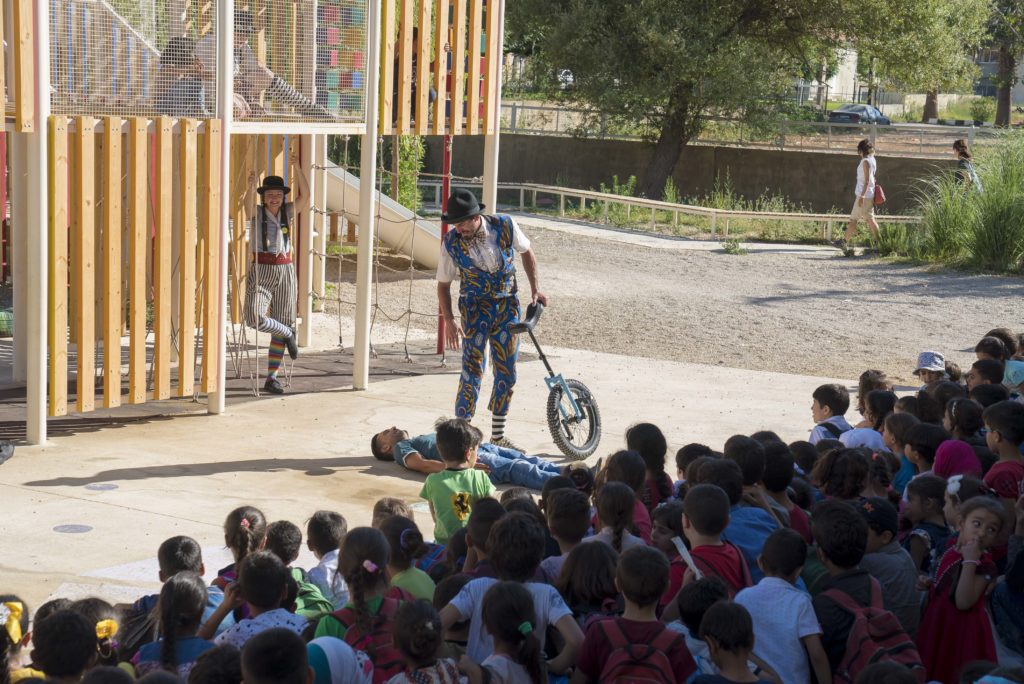
Key points
- Activities with children and their community organised with local actors can activate a space and foster ownership.
- Full ownership of a space by children and their communities contributes to long-term sustainability.
Some built interventions are designed to accommodate specific users and activities (e.g. students using a school building) while others are designed for multiple users (e.g. residents using a public park). When construction ends, project partners might want to organise strategic activities to encourage use of the space and symbolically hand over control to its users. This is more important when the built intervention seeks to change or enhance the use or function of a space.
For example, CatalyticAction implemented a number of interventions in public parks across Lebanon, encouraging people to use the parks more. The impact of new facilities for children (such as playground equipment) was enhanced through events which introduced the new spaces to children and their families. When designed with children and the community, these events can expose residents to a wide range of uses of the space and build social relations around it. This can have a significant impact on the long- term sustainability of the built intervention.

The use of a playground by children can be autonomous and unplanned. However, occasional structured sport and educational sessions can help develop relationships between different children, for example, between displaced and host children, who may have otherwise play separately.
Often the community has clear ideas on how to use a space. When the local community takes full responsibility for the activation and programming of a space, the dependency on external inputs (funds, skills, knowledge) reduces.
The designer, organisation, and other actors (including the community) may be unable to visualise all the ways that the space can be used. Moreover, the needs of the community who co-designed the intervention may change. Even the community itself can change, especially in displacement contexts. Therefore, the space should be adaptable to different uses, to allow children and their community to continue appropriating it. This means that the co-design process should build the capacity of those entrusted with the management of the space to continue a co-design and open management and maintenance approach. Unexpected and unplanned uses of built spaces are positive signs of appropriation and ownership by the local community. Unplanned uses may become a concern only when they go against the public function of a space, for example, if a public playground is occupied by a family for private use, excluding other residents.
Engaging the community from the beginning of a project is an effective way to build a sense of ownership towards it and to ensure its sustainability. When the community takes full ownership of a project, they participate in planning the use of the space, its activation and programming, adapting it to their specific needs, and contributing to its maintenance. From the start of a project, it is important to discuss with all stakeholders and reach clarity on who is going to manage the space post-construction. Depending on the context and type of intervention, there may be different actors involved. For example, this can be the NGO or local authority running the school, the playground, the child friendly space, etc. When it comes to public spaces, ongoing management becomes more complex.
In most countries, public spaces are the responsibility of local governments and the surrounding community. Local authorities and governments are mandated to create and manage public spaces by working with communities, the private sector and marginalized groups such as refugees. This balances competing interests in the pursuit of the common good. In the case of co-designed interventions with children, local governments should ensure that their management puts all children first by ensuring inclusivity, accessibility and by preventing private interests invading public space.
Place-keeping is crucial when dealing with public space. Adequate resources for its operation and maintenance should be provided to ensure long-term sustainability. Collaboration between local government, communities and, when appropriate, the private sector plays a crucial role. Local governments and other actors managing co-designed public spaces have to find the right balance between regulation and deregulation. The rules around the uses of public spaces should be given particular attention to avoid negative impacts on the most marginalised children.
For example, in many cities in the Middle East public parks are fenced and managed by guards (often hired by the local municipality). Engaging the guards from the early stages of the project would be key to ensuring that the implemented spaces are inclusive and accessible (i.e. that all children can access the park without discrimination).



